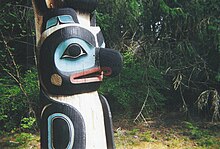Sitka National Historical Park
[11][12] Shortly thereafter, a group of influential Sitkans concerned about vandalism and the poor condition of the park in general pressured the federal government to declare the site a national monument.
[5] The Sitka National Monument was proclaimed by President William H. Taft under the Antiquities Act on March 23, 1910 to preserve the fort site and totem pole collection and protect them from further harm.
[5] Many of the poles exhibited today along the park's two miles (3.2 kilometers) of wooded pathways are replicas of the deteriorating originals, now held in protective storage.
[5] Located approximately one–half mile from the Park, the Russian Bishop's House was constructed out of native spruce in 1841-43 by Tlingit workers overseen by Finnish builders.
[21]A Bishop Innocent (Ivan Evseyevich Popov Veniaminov) of the Russian Orthodox Church, a clergyman, teacher and linguist, occupied the residence until 1853.
[22]: 7–8 The Church operated the facility as a school, residence, and place of worship for another century, until the dilapidated condition forced its abandonment in 1969 and sale in 1973 to the Park Service.

